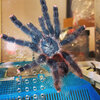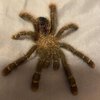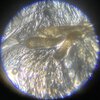RHawk
Arachnopeon
- Joined
- Nov 14, 2017
- Messages
- 26
Over the past few years, I have become quite an Aviculariinae enthusiast... and something I have noticed a lot is people inquiring about what species or what morphotype of Avicularia they have. The 2017 revision is very long and difficult to read, and it is not geared towards the casual hobbyist. Thus, I have decided to consult some fellow Avicularia enthusiasts, and to paraphrase some of the info that the 2017 revision entails, and what it means for us as hobbyists. If there is any missing information you feel I should cover with this post, feel free to shoot me some suggestions! Enjoy! 
Avicularia species & associated morphotypes
A. avicularia
M1: the standard Guyana pinktoe.. there is some red setae on the back legs (but not a ton), there is some red guard setae on the sides of the abdomen, and they appear slightly grizzled (some hairs on the legs and palps have a dark base, but white tip). sp. blue velvet, sp. Boa Vista, sp. Guyana, etc.. they are found in Brazil, Guyana, French Guyana, Venezuela, Trinidad & Tobago
M2: likely what the hobby calls A. braunshauseni. Profuse cherry-red setae on the 4th leg pair, intense red, long abdominal guard setae.. setae on legs and palps are non-grizzled. Gets very big, comes from the area surrounding Para Tucuri & Mato Grosso, Brazil.
M3: looks similar to A. geroldi, but they do retain small tufts of red setae on the abdomen (whereas TRUE geroldi have all blue). Im pretty sure this is what is called A. velutina..they originate from Venezuela.
M4: possibly hobby A. azuraklaasi, also called A. sp. Tambopata (because they are found in and around the Tambopata Reserve of Peru). Very similar in appearance to m1, the differences lie more in the setae structure, not so much outward appearance. Unlike m1, which have a discretely grizzled appearance, they will have no white tipped hairs. The guard setae and setae on the back legs will be red. Found only in Peru.
M5: sp. Bolivia/Rurrenbaque/Rio Madre/ sp. Riberalta.. looks like an m1 in outward appearance, but they possess yellow bands above the tarsi much like A. rufa. They are found in Santa Cruz, La Paz, and Beni - Bolivia. I haven’t seen these in the hobby.
M6: hobby A. metallica/sp. Kwitara, etc.. Abdominal guard setae are a brownish-grey, and all setae are highly grizzled, giving them a very frosted appearance. Gets pretty big. Comes from Guyana, French Guyana, Venezuela, Trinidad & Tobago, Suriname, and Brazil.
M7: good luck finding any photos of these guys - I’ve only ever seen one picture from the 2017 revision. They look similar to braunshauseni IMO, but apparently they have a very fuzzy grizzled appearance similar to that of m6/metallica, and rather than having an intense red setae like m2/braunshauseni, their guard setae are orange. Originated from the state of Para, Brazil. Not in the hobby
A. geroldi: It was never documented during the revision, so it’s not possible to say where geroldi falls into the A. avicularia morphs. It is said to be yet another form of A. avicularia. They have a non-grizzled appearance (no white tipped hairs like m6 or juruensis m2).. they are pretty similar to m1 in overall appearance, but the thing that stands out in geroldi is the bright blue abdominal guard setae.. they also have a blueish green hue. True geroldi have absolutely no red setae on the legs or abdomen as adults. They are a Brazilian species/morph, but specific locality is unknown to my knowledge.
A. variegata
(A note about variegata: this species wasn’t officially known to science until 2017 after Caroline Fukushima and Rogerio Bertani set out to revise the Avicularia genus. Before then, variegata was known as a ‘subspecies’ of A. avicularia, “A. avicularia variegata”. They found that this spider had enough defining morphological differences to elevate it to species status. At the same time, the type material for A. bicegoi was examined, and found to be a junior synonym of the previously named “A. avicularia variegata”. However, there is a spider that has been labeled “A. bicegoi” in the hobby, which is more than likely misidentified variant of Avicularia juruensis.
M1: sp. Amazonica, from Manaus, the REAL BICEGOI Brazil. Very grizzled appearance. Abdominal setae are a bright cherry red. Femurs are a beautiful steel blue coloration with pale yellow rings adjacent to the patellas. Only morph of variegata that is currently in US hobby.
M2: not much info on these guys. They look just as fuzzy/grizzled as m1, but more of a golden brown/greenish overall aspect (similar to the overall coloration of rufa and/or juruensis m1). Found throughout much of the same range as morphotype 1.. Not in the hobby.
M3: there are no photos of this one, and the description in the revision is very vague, but it exists! Found north of Manaus into Venezuela. Not in the hobby.
Juruensis:
(Just a note: urticans was a junior synonym of juruensis. So if you simply see the name “urticans”, not followed by a “green” or “purple”, that doesn’t indicate what morph you’ve got. What Gunter Schmitt described as “Avicularia urticans” in 1994 is what we now know as juruensis morphotype 2 - however in the European hobby, juruensis morphotype 1 was also given the epithet “urticans ‘green’”, after the overall coloration. I have seen these spiders sold in the United States simply (and incorrectly) labeled “urticans”. Until your spider attains a size of 1.5-2 inches, it’s impossible to discern between the two.
M1: what the hobby calls aurantiaca, ulrichea, sp. Pucallpa, urticans “green”. Non grizzled appearance, setae are long, scraggly, and uniform in color. Color varies from orangish yellow to greenish brown.. Leg banding above the tarsi (feet) vary from a yellowish color to an off-white. Found across Peru and Brazil
M2: what the hobby calls sp. Peru purple, huriana, urticans “purple”. Very grizzled much like A. avicularia morphotype 6, lots of short, dense, fuzzy white tipped setae. Leg banding will vary from a yellowish color to an off-white. They have red abdominal guard setae, and they get a purple hue to their carapace and legs as they get older... this is mostly prevalent in the Peruvian locality - hence the name “sp. Peru purple”. Juruensis also get very big. Found throughout Peru, Colombia, Ecuador, and Brazil.
Purpurea:
They aren’t numbered like the previous 3 species, but rather, they are separated into “northern” & “southern” variants.
North: the standard hobby purpurea. Non-grizzled setae on legs and palps. The abdomen is jet black with a velvety appearance. The carapace appears black, but under natural sunlight/LED lighting, it has an electric purple sheen.
South: sp. Ecuador, looks similar to the other type, but has a bit of a grizzled appearance (very discrete though), the main thing that differentiates them from their northern counterparts is that the females get these rusty red/reddish brown chevron markings on the abdomen that begin to disappear as the female is reaching maturity. There is little difference between males of the northern and southern variants. Not as common as the northern variant in the hobby. In the revision, this “morph” was only documented in Peru, but our hobby stock comes from Ecuador
CONCLUSION:
Although many of the former species are now lumped under these larger “umbrella” species, it is NOT clearly defined how genetically different they really are. Many of them described species such as braunshauseni, geroldi, azuraklaasi, ulrichea, etc never had any type specimens preserved and sent off to museums, therefor they were labeled nomen dubium, or “doubtful name”... it doesn’t necessarily mean those species absolutely do not exist, but it’s hard to say for certain when there was no material for scientists to examine. Because species like metallica, braunshauseni, azuraklaasi, and geroldi are lumped under A. avicularia, and species like huriana, ulrichea, and aurantiaca are lumped under juruensis, does NOT mean that they should be bred together. The reason they were classified in the manner that they were is because these former “species” did not have enough defining morphological features to differentiate them as species (i.e. spermathacae shape, male palpal bulb shape, and so on). A. avicularia and A. juruensis have enormous ranges across a good portion of South America, separated by geographical features such as rivers, mountains, etc, and there is still a chance that they have become genetically different enough to be considered separate species in the future. Now that scientists have collected material from all of the known localities for the nomen dubium species, they will be able to examine them in the future. The purpose of the revision was not to be the end-all-say-all on Avicularia classification, but rather to lay the groundwork for future work with the genus. In the meantime, you can still label your spiders as “aurantiaca”, or “braunshauseni”, etc. I hope this will help shed some light on what is such a confusing genus for many!
Avicularia species & associated morphotypes
A. avicularia
M1: the standard Guyana pinktoe.. there is some red setae on the back legs (but not a ton), there is some red guard setae on the sides of the abdomen, and they appear slightly grizzled (some hairs on the legs and palps have a dark base, but white tip). sp. blue velvet, sp. Boa Vista, sp. Guyana, etc.. they are found in Brazil, Guyana, French Guyana, Venezuela, Trinidad & Tobago
M2: likely what the hobby calls A. braunshauseni. Profuse cherry-red setae on the 4th leg pair, intense red, long abdominal guard setae.. setae on legs and palps are non-grizzled. Gets very big, comes from the area surrounding Para Tucuri & Mato Grosso, Brazil.
M3: looks similar to A. geroldi, but they do retain small tufts of red setae on the abdomen (whereas TRUE geroldi have all blue). Im pretty sure this is what is called A. velutina..they originate from Venezuela.
M4: possibly hobby A. azuraklaasi, also called A. sp. Tambopata (because they are found in and around the Tambopata Reserve of Peru). Very similar in appearance to m1, the differences lie more in the setae structure, not so much outward appearance. Unlike m1, which have a discretely grizzled appearance, they will have no white tipped hairs. The guard setae and setae on the back legs will be red. Found only in Peru.
M5: sp. Bolivia/Rurrenbaque/Rio Madre/ sp. Riberalta.. looks like an m1 in outward appearance, but they possess yellow bands above the tarsi much like A. rufa. They are found in Santa Cruz, La Paz, and Beni - Bolivia. I haven’t seen these in the hobby.
M6: hobby A. metallica/sp. Kwitara, etc.. Abdominal guard setae are a brownish-grey, and all setae are highly grizzled, giving them a very frosted appearance. Gets pretty big. Comes from Guyana, French Guyana, Venezuela, Trinidad & Tobago, Suriname, and Brazil.
M7: good luck finding any photos of these guys - I’ve only ever seen one picture from the 2017 revision. They look similar to braunshauseni IMO, but apparently they have a very fuzzy grizzled appearance similar to that of m6/metallica, and rather than having an intense red setae like m2/braunshauseni, their guard setae are orange. Originated from the state of Para, Brazil. Not in the hobby
A. geroldi: It was never documented during the revision, so it’s not possible to say where geroldi falls into the A. avicularia morphs. It is said to be yet another form of A. avicularia. They have a non-grizzled appearance (no white tipped hairs like m6 or juruensis m2).. they are pretty similar to m1 in overall appearance, but the thing that stands out in geroldi is the bright blue abdominal guard setae.. they also have a blueish green hue. True geroldi have absolutely no red setae on the legs or abdomen as adults. They are a Brazilian species/morph, but specific locality is unknown to my knowledge.
A. variegata
(A note about variegata: this species wasn’t officially known to science until 2017 after Caroline Fukushima and Rogerio Bertani set out to revise the Avicularia genus. Before then, variegata was known as a ‘subspecies’ of A. avicularia, “A. avicularia variegata”. They found that this spider had enough defining morphological differences to elevate it to species status. At the same time, the type material for A. bicegoi was examined, and found to be a junior synonym of the previously named “A. avicularia variegata”. However, there is a spider that has been labeled “A. bicegoi” in the hobby, which is more than likely misidentified variant of Avicularia juruensis.
M1: sp. Amazonica, from Manaus, the REAL BICEGOI Brazil. Very grizzled appearance. Abdominal setae are a bright cherry red. Femurs are a beautiful steel blue coloration with pale yellow rings adjacent to the patellas. Only morph of variegata that is currently in US hobby.
M2: not much info on these guys. They look just as fuzzy/grizzled as m1, but more of a golden brown/greenish overall aspect (similar to the overall coloration of rufa and/or juruensis m1). Found throughout much of the same range as morphotype 1.. Not in the hobby.
M3: there are no photos of this one, and the description in the revision is very vague, but it exists! Found north of Manaus into Venezuela. Not in the hobby.
Juruensis:
(Just a note: urticans was a junior synonym of juruensis. So if you simply see the name “urticans”, not followed by a “green” or “purple”, that doesn’t indicate what morph you’ve got. What Gunter Schmitt described as “Avicularia urticans” in 1994 is what we now know as juruensis morphotype 2 - however in the European hobby, juruensis morphotype 1 was also given the epithet “urticans ‘green’”, after the overall coloration. I have seen these spiders sold in the United States simply (and incorrectly) labeled “urticans”. Until your spider attains a size of 1.5-2 inches, it’s impossible to discern between the two.
M1: what the hobby calls aurantiaca, ulrichea, sp. Pucallpa, urticans “green”. Non grizzled appearance, setae are long, scraggly, and uniform in color. Color varies from orangish yellow to greenish brown.. Leg banding above the tarsi (feet) vary from a yellowish color to an off-white. Found across Peru and Brazil
M2: what the hobby calls sp. Peru purple, huriana, urticans “purple”. Very grizzled much like A. avicularia morphotype 6, lots of short, dense, fuzzy white tipped setae. Leg banding will vary from a yellowish color to an off-white. They have red abdominal guard setae, and they get a purple hue to their carapace and legs as they get older... this is mostly prevalent in the Peruvian locality - hence the name “sp. Peru purple”. Juruensis also get very big. Found throughout Peru, Colombia, Ecuador, and Brazil.
Purpurea:
They aren’t numbered like the previous 3 species, but rather, they are separated into “northern” & “southern” variants.
North: the standard hobby purpurea. Non-grizzled setae on legs and palps. The abdomen is jet black with a velvety appearance. The carapace appears black, but under natural sunlight/LED lighting, it has an electric purple sheen.
South: sp. Ecuador, looks similar to the other type, but has a bit of a grizzled appearance (very discrete though), the main thing that differentiates them from their northern counterparts is that the females get these rusty red/reddish brown chevron markings on the abdomen that begin to disappear as the female is reaching maturity. There is little difference between males of the northern and southern variants. Not as common as the northern variant in the hobby. In the revision, this “morph” was only documented in Peru, but our hobby stock comes from Ecuador
CONCLUSION:
Although many of the former species are now lumped under these larger “umbrella” species, it is NOT clearly defined how genetically different they really are. Many of them described species such as braunshauseni, geroldi, azuraklaasi, ulrichea, etc never had any type specimens preserved and sent off to museums, therefor they were labeled nomen dubium, or “doubtful name”... it doesn’t necessarily mean those species absolutely do not exist, but it’s hard to say for certain when there was no material for scientists to examine. Because species like metallica, braunshauseni, azuraklaasi, and geroldi are lumped under A. avicularia, and species like huriana, ulrichea, and aurantiaca are lumped under juruensis, does NOT mean that they should be bred together. The reason they were classified in the manner that they were is because these former “species” did not have enough defining morphological features to differentiate them as species (i.e. spermathacae shape, male palpal bulb shape, and so on). A. avicularia and A. juruensis have enormous ranges across a good portion of South America, separated by geographical features such as rivers, mountains, etc, and there is still a chance that they have become genetically different enough to be considered separate species in the future. Now that scientists have collected material from all of the known localities for the nomen dubium species, they will be able to examine them in the future. The purpose of the revision was not to be the end-all-say-all on Avicularia classification, but rather to lay the groundwork for future work with the genus. In the meantime, you can still label your spiders as “aurantiaca”, or “braunshauseni”, etc. I hope this will help shed some light on what is such a confusing genus for many!
































